D-19 rocket complex with a P-39 ballistic missile
The decision to develop a new rocket was made in the middle of 1971. SKB-385 / KB engineering, headed by V.P. Makeev, was instructed to create a new missile system for submarines. It was necessary to create a three-stage solid-fuel rocket with a starting weight of about 75 and a length of up to 15. The product had to carry a single-piece or split head (3-5 or 8-10 of warheads) and deliver warheads to a distance of 10 km. The project of the new missile complex received the designation D-19 and the cipher "Typhoon". The rocket was designated as P-39.
For about a year, the design bureau has completed the development of an advance project of a new complex. At this stage, the main features of the promising complex were identified, which were later brought to use in the final project. A general product architecture was formed and launch methods were defined. Also, engineers completed the selection of the main units of the future rocket. It was proposed to transport the missile on a carrier with the help of a shock-absorbing rocket-launch system (ARSS) and to launch without filling the launch shaft. In addition, the preliminary design implied the use of a starting engine placed on the nozzle of the first-stage mid-flight propulsion system.
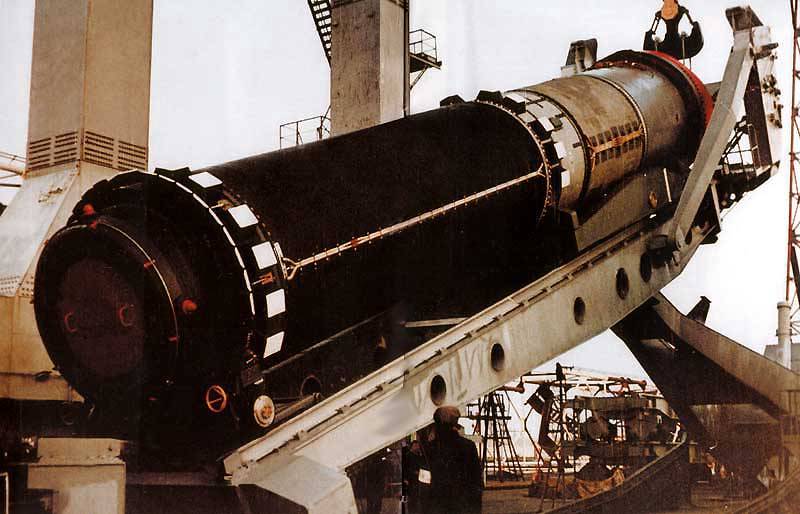
Rocket R-39 during loading on the submarine. Photo Rbase.new-factoria.ru
16 September 1973 of the Year The USSR Council of Ministers decided to begin the development of the technical design of the D-19 / P-39 rocket complex. The lead developer of the project was appointed KB Mechanical Engineering. Also involved in the project related organizations. In particular, the development of a first-stage solid-fuel engine was commissioned by Yuzhnoye Design Bureau and Altai Scientific and Production Association. The September decree also asked for the development of a promising nuclear submarine of the 941 project, which was to be the carrier of the new missiles.
The outline of the D-19 complex was completed by the end of 1974. By this time, some changes had been made to the project, which had a definite impact on the rocket's appearance. In particular, due to changes in the layout and composition of the units, the loading mass of the product (including APCC, launch systems, etc.) increased to 90 T. The draft design implied several combat equipment options, with one to ten different warheads bearing different capacities.
In the middle of 1975, the technical task was again changed and approached its final appearance. The P-39 rocket was supposed to carry ten 100 kt warheads, attack targets at a distance of 10 thousand km and launch using a powder pressure accumulator. The ratio of the required range and combat load received the unofficial nickname of "ten to ten." In the future, the requirements for the project have been changed again. The new versions of this document stipulated the change of fuel of the second and third stages. In addition, in the latest version of the task, the flight range was reduced to 8300 km.
Within the framework of the D-19 / P-39 project, several original ideas were proposed and developed concerning the architecture of the rocket. In particular, it was proposed to use a new design of the casing of the steps, which would significantly reduce the starting weight of the rocket. Shells were proposed to be made of high-strength organic fiber by winding using cocoon technology. While providing the required strength, such cases were significantly lighter than traditional metal ones.
The idea of "recessed" engine placement was again applied. Nozzles were proposed to be partially placed inside the engine housings, which made it possible to reduce the dimensions of the entire product assembly. At the same time, however, the main features of solid-fuel engines did not allow for a relatively large reduction in step sizes. In addition, the authors of the project were forced to use small transitional compartments connecting the stages to each other in the rocket design.
The first stage of the product Р-39 was equipped with a solid-fuel 3Д65 engine, unified with the units of the РТ-23 rocket. The engine received a charge of solid fuel with an internal channel of a star-shaped section. 48 tons of fuel in the liquid form was proposed to be poured into the body during the assembly of the rocket, after which it was supposed to freeze. The form of charge was calculated in such a way that during the last 17 seconds of engine operation there was a decrease in thrust. This made it possible to improve the controllability of the rocket before the discharge of the spent first stage. Inside the nozzle of the first-stage engine was placed a powder pressure accumulator designed to pull the rocket out of the launcher.
To control the flight of the rocket in the initial part of the flight was proposed using special gas injection valves located on the stationary nozzle. Eight pairs of such devices allowed changing the total thrust vector and controlling the rocket on all three channels.
The second stage of the rocket also received a solid-fuel engine with a charge having a central channel of complex multipath form. An interesting feature of the second stage engine was the use of a telescopic rocking nozzle. Before switching on the engine, the nozzle had to be transferred to the working view about the displacement of the moving part. By changing the inclination of the nozzle, the rocket control system could change the trajectory parameters. At the same time, separate small-sized engines were used for yaw control.
The third stage received a solid-fuel engine, similar to the systems of other stages. The engine was equipped with a telescopic nozzle without the possibility of changing the thrust vector. For maneuvering, it was proposed to use a liquid power unit of a combat stage integrated with the third. The engines and fuel tanks of the breeding stage were mounted on the sides of the third stage casing. It was proposed to attach the instrument compartment divided into two parts to the head of the latter. In the head part of it, the astrocorrection apparatus was placed on a gyro-stabilized platform, in the tail part - inertial apparatus with a frame suspended on shock absorbers. The astrovising device was covered with a drop dome.
Fastenings for warheads were located on the body of the third stage, next to the units of the breeding stage. After 1975, only one warhead was developed, carrying ten warheads with an 100 power. From external influences, warheads and equipment were protected by a fairing discharged in flight, formed by several conical surfaces.
Rocket R-39, like some previous domestic weapons for submarines, was to receive a combined control system. The main tasks of flight control were assigned to inertial equipment capable of tracking the movement of the rocket in three planes and issuing commands to the steering systems. After the discharge of the spent first stage, an astrocorrection session should be performed with the missile coordinates specified and an additional change in the flight path. Updated control systems have improved the accuracy of the hit compared to existing samples. The estimated QUO of the new missile was 500 m.
A promising missile for submarines received a special depreciation rocket-launch system, the task of which was to ensure the transportation and launch of the product. ARSS received a corpus of characteristic mushroom shape, intended for installation on the head of the rocket. Inside the system, various units were placed, including means of holding the rocket and a gas generator for optimal release of the rocket from the water. It was also proposed to install several belts with rubber-metal shock absorbers on the body of the rocket. After the release of the rocket from the water should have been a discharge of all attachments. For this, a set of several low-power solid-fuel engines was used.
A new type of ballistic missile had a total length of 16 m and a case diameter of 2,4 m. The total weight of the product was 90 t, while the missile without an ARSS had a mass of 84 t. The throw weight exceeded 2,5 t.
The D-19 complex received an original launcher with non-standard means of fastening the rocket. On the upper section of the launch shaft, it was proposed to install a special support ring on which the external part of the ARSS was placed. Thus, in the transport position, the P-39 rocket should have been suspended. The dimensions of the rocket-launch device and the belt with shock absorbers protected the rocket from movements in the horizontal plane.
The launch of the new rocket was supposed to look like this. After the pre-launch preparation with the calculation of the flight task and data entry into the rocket automatics, the command at the start should have followed. At the same time, the charge of the powder accumulator was ignited. In addition, the APSS gas generator was turned on. The pressure accumulator was supposed to create high pressure in the launcher, pushing the rocket out of the mine. When a rocket hit the water, the gas generator created a gas cavity and ensured the correct withdrawal of the product from the water. After rising above the surface of the water, the first stage sustainer must have started. In case of engine failure, the system of automatic diversion of the rocket to the side of the carrier was activated.
The development of the D-19 / P-39 project was completed in 1977 year, after which testing of new systems began. By this time, the requirements were again changed. The maximum range was reduced to 8300 km, and also adjusted the timing of the completion of the project and the adoption of the complex for service.
As before, it was decided to carry out the test in three stages: on the submerged stand, on the ground stand and on the submarine carrier. The first stage of testing was launched in September 1977 of the year and was conducted on the Black Sea. With the help of the submersible stand PS-65, 9 executed special layouts. For these products, a simplified first-stage solid fuel engine, 3D65B, was developed, featuring a lower fuel charge. Such a product could completely simulate the operation of the 3D65 engine for eight seconds, after which the mock-up had to fall into the water. The throwing tests of the P-39 layouts ended at the end of 1978, and passed without comment.
In December, the submarine K-1978 of the 153 project joined the test. This boat was built on the project 619, but later underwent modernization. In the central compartment of the case, one launcher of a new type was installed. The crew of the K-629 performed seven test launches of mockups. The shooting from the test submarine continued until the autumn of the 153.
At the very beginning of 1980, the second stage of testing was launched using the NSC-65 ground test bench at the Nenoks site. From January to December, five test launches of full-fledged missiles were carried out, but all of them ended in accidents. According to the results of these checks, the rocket underwent some changes, and in addition, production technologies were improved. 27 December 1980 of the year was the first successful launch of the P-39 from the ground stand.
Trials at the Nenox site continued until the summer of 1982. 17 launches were performed, mainly at intermediate ranges. Due to the lack of perfection of the design of the new rocket, only half of the starts were successful. According to the test results, a new stage of the rocket and the whole complex modifications began.
In 1972, the development of the future carrier of new missiles began. The creation of the nuclear submarine "941" (code "Shark") was entrusted to TsKBMT "Rubin" led by S.N. Kovalev. The main requirements for the new submarine were associated with the peculiarities of the P-39 missiles, which were distinguished by large dimensions. In addition, the customer required to equip the boat with two dozen launch shafts. As a result, the world's largest submarine was created. In June, the construction of a new type of head cruiser, the TK-1976 (later Dmitry Donskoy), was launched on 208. In September, the 1980 th submarine was launched.
In December, the 1981 of the TK-208 nuclear submarine first entered the sea for testing the D-19 complex with the P-39 rocket. Over the year, 13 tests were completed, of which 11 was successful. 12 December 1982, the joint testing of the submarine and the rocket ended in salvo firing four missiles. Tests recognized successful.
In May, the 1983 of the D-9 / P-39 missile complex officially adopted as the main weapons strategic missile submarines of the 941 "Shark" project. Until the end of the eighties, the Navy received six "Sharks", each of which could carry on 20 P-39 missiles. Thus, on board each submarine could be placed on 200 warheads or 1200 in total on all submarines of the project.
To support the combat operation of the submarines of the 941 project, a special 11570 rocket-propelled transport-rocket launcher was designed and built. Onboard the vessel “Alexander Brykin” with a displacement of more than 11 thousand tons there were 16 containers for the transport of P-39. To transfer this weapon to the submarines, the ship was equipped with a 125 tonne lifting crane. According to some sources, the crew of the Alexander Brykin could reload the Shark launchers in the open sea.
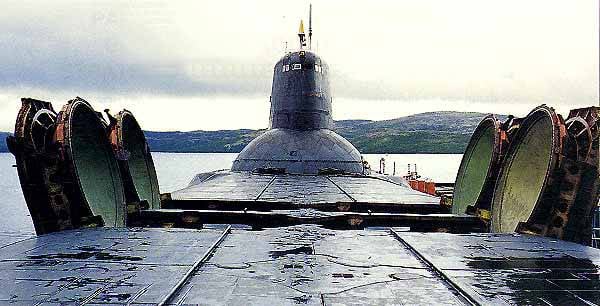
Shark launchers with open lids. Photo Rbase.new-factoria.ru
Already in the spring of 1984, the development of an improved D-19U complex with a P-39U rocket began. The objective of this project was to improve the performance through the use of new control systems and a modernized combat unit. The latter was developed in parallel for use in new versions of the P-39 and P-29РM missiles. The development of an updated missile system and subsequent tests took several years. In 1988, the D-19U / P-39U complex was put into service. The new rocket in terms of accuracy close to the similar land-based systems.
Another missile modernization project using the new control systems received the designation P-39M and the cipher "Grom". The development of this project was carried out during the nineties. After testing, the new system was put into service in 2003. It was the latest version of the D-19 complex, which has come down to adoption.
Since 1986, the P-XNUMHUTTH Bark project has been developed. It was required to bring the maximum firing range to 39 thousand. Km with the possibility of delivery to the targets of ten warheads. It was assumed that the existing complex will receive the existing submarine type "Shark". In addition, promising submarines of the Borey 10 project were to become carriers of the P-39UTTH.
The rocket received a new system for launching from the submerged position of the carrier with the passage through the ice, and was also equipped with an upgraded control equipment with a mode of flight along a flat trajectory. The type of solid fuel used by engines of all stages has also changed. Such changes allowed to improve the main technical and operational characteristics of the rocket.
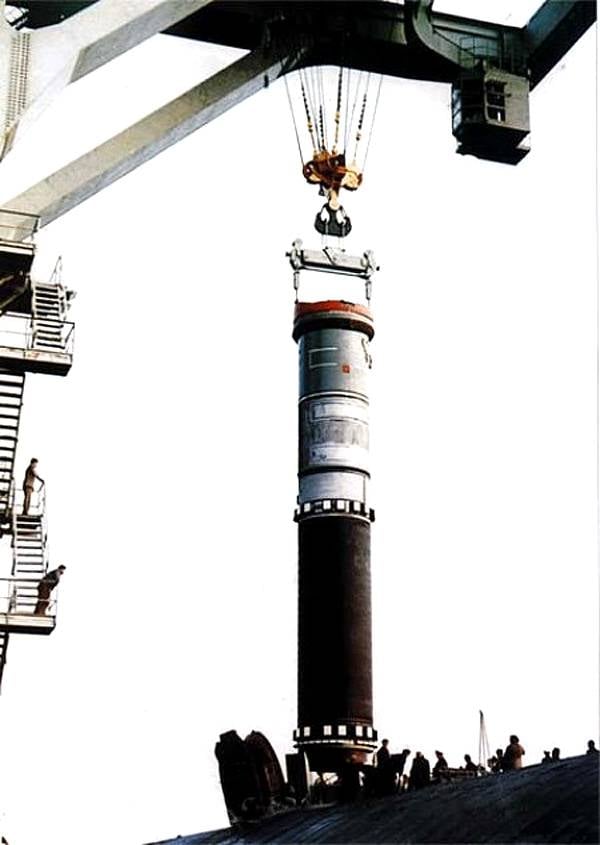
Loading missile P-39 on the submarine cruiser type "Shark". Photo Militaryrussia.ru
The first draft of the D-19UTTH / P-39UTTH project was completed in 1991, but new improvements were needed soon. In connection with the collapse of the USSR, the project had to be reworked, taking into account the use of only domestic components. This fact, as well as a sharp reduction in funding led to a delay in work. Checks of the updated rocket managed to start only in 1996 year.
In 1998, the Ministry of Defense decided to abandon the further development of the Bark project. Such a decision was due to both the technical problems of the project, which required further work, and a lack of funding. According to the estimates of the project developers, at the time of the work stoppage, at least eight test launches were required. However, insufficient funding led to an unacceptable increase in the period for assembling products: one rocket was built for about three years. In connection with such a difficult situation, the customer decided to abandon the further development of the P-39UTTH rocket. Soon, a new solid propellant missile project for submarines was launched, called the Bulava.
During the testing of a new missile system and rocket operation fleet Almost 70 launches of the mock-up and full-fledged military products were completed. After testing and testing new missiles were completed, the vast majority of launches ended with the successful completion of the assigned tasks. During the operation of the missiles, the crews of Project 941 submarines repeatedly fired in volleys. In addition, in March and December 1997, two salvo firing took place using the entire ammunition. They were performed by the crews of the cruisers TK-20 and TK-208.
The last launch of the P-39 rocket took place on 11 on December 2003 of the year. By this time, the situation with the D-19 complex and its carriers has seriously deteriorated. Production of serial missiles was discontinued, and their warranty periods were coming to an end. Because of this, in 2004, the exploitation of the P-39 missiles of all modifications was stopped. Simultaneously with the reduction in the number of available rockets, due to the need to reduce costs, the “Shark” type submarines were brought to the reserve. In 2004, the last representatives of this project came out of service.
State Rocket Center. V.P. Makeeva attempted to extend the life of existing missiles, but this work did not end in success. In addition, as part of the implementation of existing international treaties, the disposal of the remaining rockets began. The latest P-39 products were disposed of in 2012. The further fate of submarines without weapons was a topic for discussion at various levels.
At the beginning of the two thousandth, modernization of the nuclear submarine TK-208 "Dmitry Donskoy" for a special project 941UM. The submarine was repaired and received equipment for the use of new missiles "Bulava". During the two thousand years, the submarine took an active part in the testing of a new missile system. The TK-208 served as a platform for testing until the completion of the new 955 "Borey" submarine project.
The D-19 / P-39 missile system can be considered the most successful domestic development of its class. The result of long-term research and design work was the emergence of a number of new original ideas of various kinds, which were combined in the design of a new solid-fuel rocket. In 1983, the P-39 rocket officially became the weapon of the submarine fleet, and over the next few years a relatively large group of such missiles and their carriers was deployed. However, the long-term operation of the D-19 complex was hindered by numerous economic, political and other problems of the past decades. They did not allow to complete the modernization of the project "Bark".
As a result, the exploitation of the P-39 missiles has now been completely stopped. Three of its carriers were disposed of, one (TK-208) is used as an experimental submarine for new projects, and two more (TK-17 Arkhangelsk and TK-20 Severstal) are in reserve. Prospects for cruisers from the reserve look pessimistic. Further operation of these submarines is impossible, because of what is expected to make a decision on their disposal. Nevertheless, the submarine of the 941 project still retains the honorary title of the largest submarines in the world, and the P-39 product can deservedly be considered one of the best domestic ballistic missiles of submarines.
Based on:
http://rbase.new-factoria.ru/
http://makeyev.ru/
http://nevskii-bastion.ru/
http://deepstorm.ru/
http://submarines.narod.ru/
http://militaryrussia.ru/blog/topic-671.html
Apalkov Yu.V. Submarines of the Soviet Navy 1945-1991 Volume III: - M: Morkniga, 2012
Shirokorad A.B. Weapons of the domestic fleet. 1945-2000. - Minsk: “Harvest”, 2001
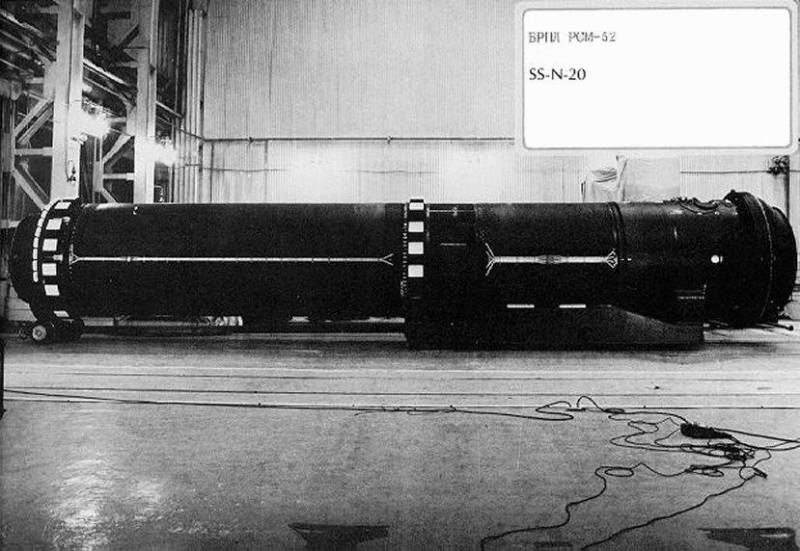
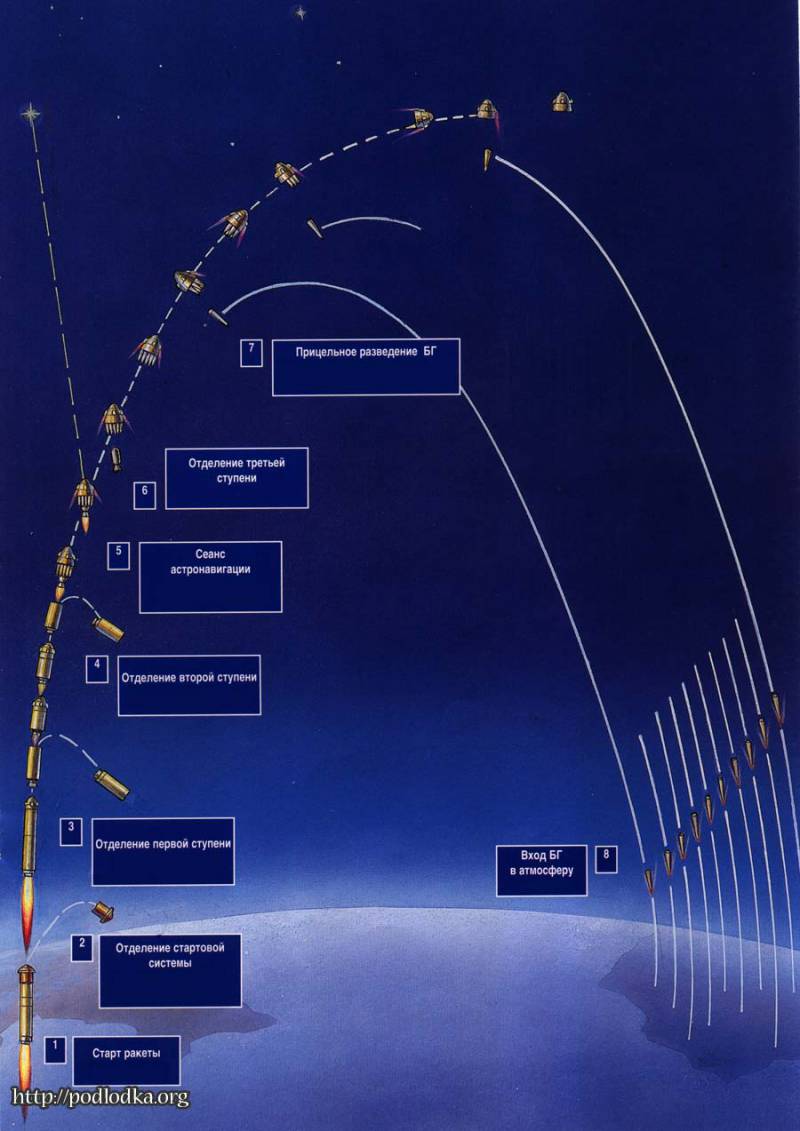
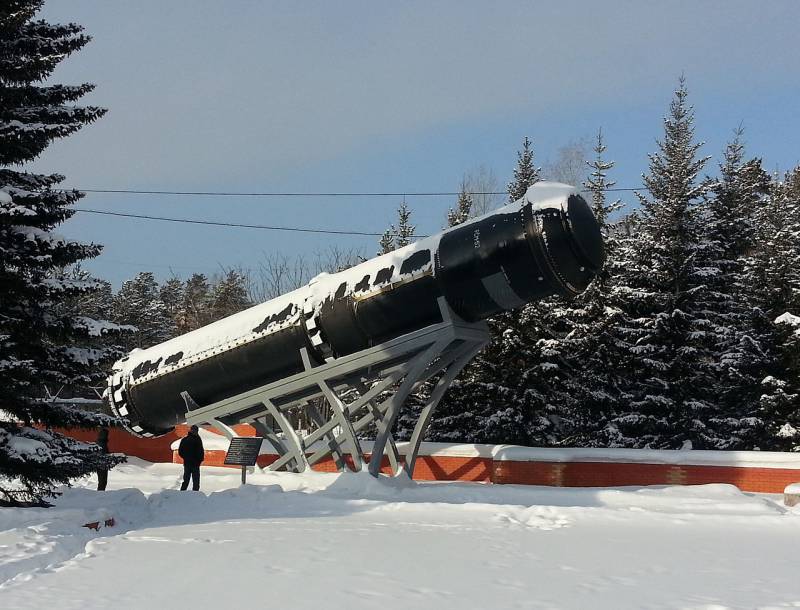
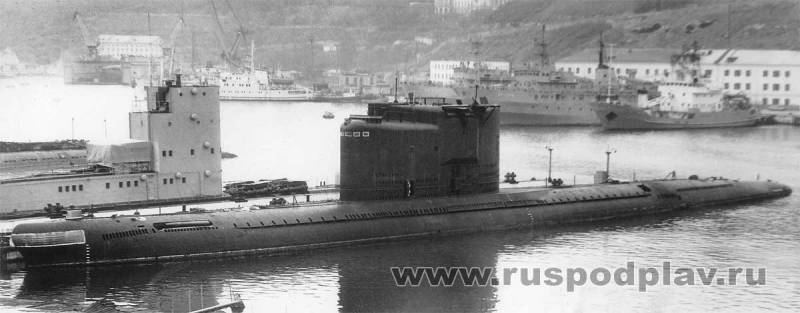
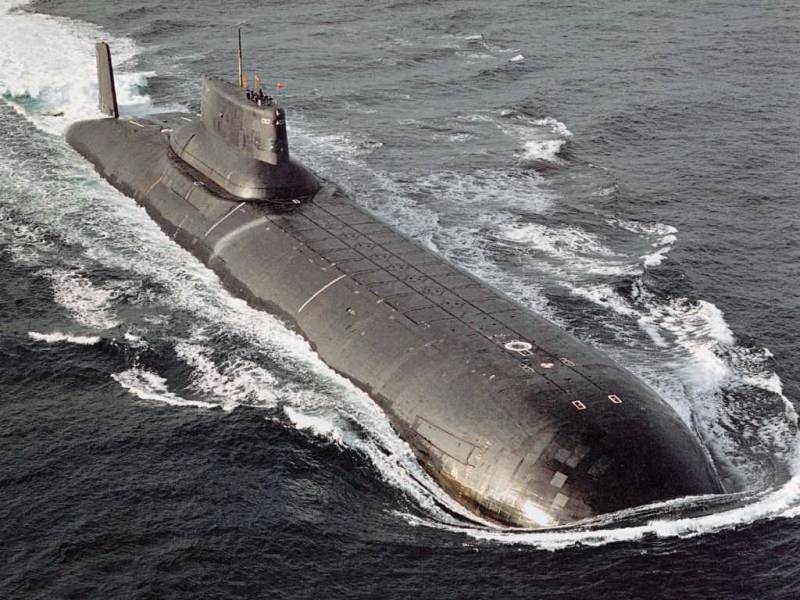
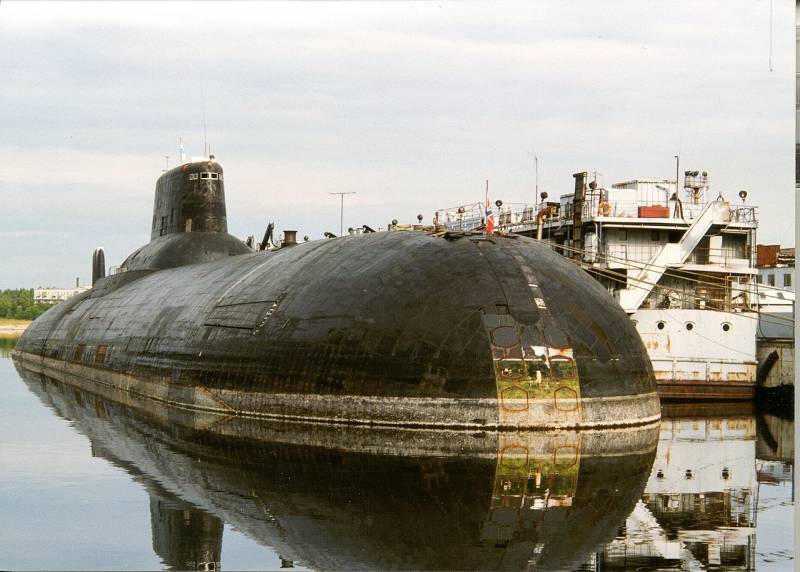
Information